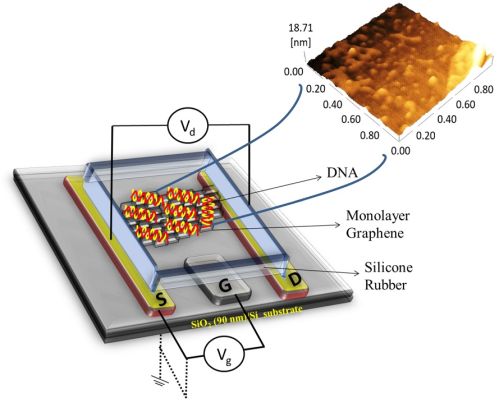|
|
|
|
|
|
| Graphene-based transistors could soon help diagnose genetic diseases. |
TSUKUBA, Japan, Feb 24, 2017 - (ACN Newswire) - Researchers in India and Japan have developed an improved method for using graphene-based transistors to detect disease-causing genes.
 | | Schematic of a graphene-based field-effect transistor (left) and an atomic force microscopy image of graphene covered with single-stranded probe DNA (right). |
Graphene field-effect transistors (GFETs) can detect harmful genes through DNA hybridization, which occurs when a 'probe DNA' combines, or hybridizes, with its complementary 'target DNA.' Electrical conduction changes in the transistor when hybridization occurs.
Nobutaka Hanagata of Japan's National Institute for Materials Science and colleagues improved the sensors by attaching the probe DNA to the transistor through a drying process. This eliminated the need for a costly and time-consuming addition of 'linker' nucleotide sequences, which have been commonly used to attach probes to transistors.
The research team designed GFETs that consist of titanium-gold electrodes on graphene - a one-atom-thick layer of carbon - deposited on a silicon substrate. Then they deposited the DNA probe, in a saline solution, onto the GFET and left it to dry. They found that this drying process led to direct immobilization of the probe DNA on the graphene surface without a need for linkers. The target DNA, also in saline solution, was then added to the transistor and incubated for four hours for hybridization to occur.
The GFET operated successfully using this preparation method. A change in electrical conduction was detected when the probe and target combined, signaling the presence of a harmful target gene. Conduction did not change when other non-complementary DNA was applied.
DNA hybridization is usually detected by labelling the target with a fluorescent dye, which shines brightly when it combines with its probe. But this method involves a complicated labelling procedure and needs an expensive laser scanner to detect fluorescence intensity. GFETs could become a cheaper, easier to operate, and more sensitive alternative for detecting genetic diseases.
"Further development of this GFET device could be explored with enhanced performance for future biosensor applications, particularly in the detection of genetic diseases," conclude the researchers in their study published in the journal Science and Technology of Advanced Materials.
Article information:
Arun Kumar Manoharan, Shanmugavel Chinnathambi, Ramasamy Jayavel and Nobutaka Hanagata
"Simplified detection of the hybridized DNA using a graphene field effect transistor"
Science and Technology of Advanced Materials, 2017; 18:1, 43-50.
http://dx.doi.org/10.1080/14686996.2016.1253408
For further information please contact:
Nobutaka Hanagata,
Nanotechnology Innovation Station, National Institute for Materials Science, Tsukuba, Japan
HANAGATA.Nobutaka@nims.go.jp
Journal information
Science and Technology of Advanced Materials (STAM), http://www.tandfonline.com/stam is an international open access journal in materials science. The journal covers a broad spectrum of topics, including synthesis, processing, theoretical analysis and experimental characterization of materials. Emphasis is placed on the interdisciplinary nature of materials science and on issues at the forefront of the field, such as energy and environmental issues, as well as medical and bioengineering applications.
For more information about STAM please contact
Mikiko Tanifuji
Publishing Director
Science and Technology of Advanced Materials
E-mail: TANIFUJI.Mikiko@nims.go.jp
Press release distributed by ResearchSEA for Science and Technology of Advanced Materials.
Topic: Research and development
Source: Science and Technology of Advanced Materials
Sectors: Electronics, Materials & Nanotech, BioTech
http://www.acnnewswire.com
From the Asia Corporate News Network
Copyright © 2026 ACN Newswire. All rights reserved. A division of Asia Corporate News Network.
|
|
|

|
|
|
|
| Science and Technology of Advanced Materials |
| July 8, 2025 06:48 HKT/SGT |
|
Progress towards potassium-ion batteries |
| June 23, 2025 00:15 HKT/SGT |
|
New method to blend functions for soft electronics |
| May 5, 2025 03:20 HKT/SGT |
|
New Database of Materials Accelerates Electronics Innovation |
| Jan 28, 2025 08:00 HKT/SGT |
|
High-brilliance radiation quickly finds the best composition for half-metal alloys |
| Dec 3, 2024 23:15 HKT/SGT |
|
Machine learning used to optimise polymer production |
| Oct 25, 2024 23:00 HKT/SGT |
|
Machine learning can predict the mechanical properties of polymers |
| July 30, 2024 20:00 HKT/SGT |
|
Dual-action therapy shows promise against aggressive oral cancer |
| Apr 17, 2024 22:00 HKT/SGT |
|
A new spin on materials analysis |
| Apr 12, 2024 18:00 HKT/SGT |
|
Kirigami hydrogels rise from cellulose film |
| Feb 27, 2024 08:00 HKT/SGT |
|
Sensing structure without touching |
| More news >> |
 |
|
|